Photo
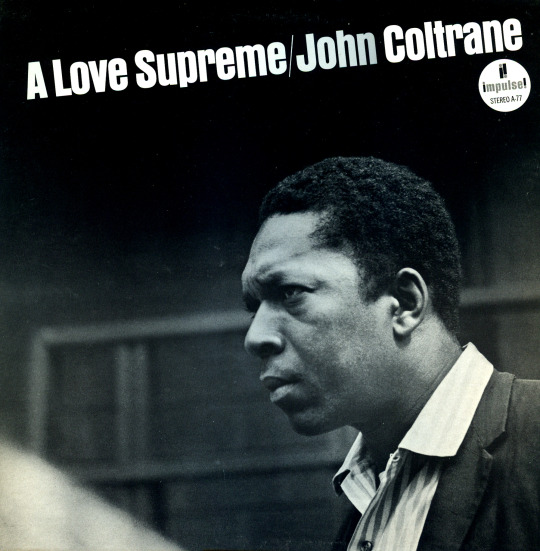
Album 0053
John Coltrane - A Love Supreme (1965)
Genre: Avant-Garde Jazz
Patrick: Score: 7.0
Nik: I have to say the reason I kept the albums blog for so long under wraps was really the fear of how to approach this album, because I just don’t really get it. I do feel the jam and the catwalk bass vibes of Acknowledgement(complete with some fond fast food-related jokes I remember from /mu/), and what the narrative of A Love Supreme is supposed to represent. It is even conveniently spelled out in the track titles, the album being a spiritual ode to seeking religious enlightenment, the resolve that drives it, and ending with an epic prayer in the form of Psalm, which is Coltrane’s way of “singing” his self-penned prayer featured in the liner notes with his saxophone. It’s breath-taking to hear jazz used as a vessel for such a passionate cry, that echoes both of salvation and a hopeful future, and leaves a weary sigh of the language of the blues.
Besides Resolution having a crazy narcoleptic riff moments in the introduction and Acknowledgement being a classic, the rest of the album hinges on interplay, one I was never well-versed in for all my jazz history, when all I am ever capable of focusing on is the starman of each picture; in this case, Coltrane’s saxophone, but there’s not much to say about his playing here. He already achieved his mastery of the instrument long ago, but it’s novel to see it used in such a spiritual context, but for me at least, it is just that, novelty.
Score: 6.5
AGGREGATE SCORE: 6.75
CHOICE CUTS:
Part 1: Acknowledgement
Part 4: Psalm(read the lyrics in sync to this video, seriously)
2 notes
·
View notes
Photo

“It takes more courage not to grow up, honestly."
Album 0052
The Beach Boys - The Beach Boys Today! (1965)
Genre: Pop Rock, Sunshine Pop
Patrick: Score: 5.0
Nik: This should, theoretically, be among the good stuff, but what’s the main problem about Today! is that it is at such a perfect cusp between the Beach Boys’ surf pop and Pet Sounds phases, but it excels and embraces none of those styles, instead having its own fair share of schmaltz. I consider it a pretty awkward transition and I know Brian Wilson could have done better. Perhaps I only say this in retrospect.
But that’s not it, let’s talk about the good stuff: So after Brian Wilson gave up going on tours and decided the studio is his playground, you can see at first, The Beach Boys trying to reinterpret their surf rock sound with varied instrumentation and careful volume of the instruments and their placement. They play Bobby Freeman’s “Do You Wanna Dance“ with jolly timpani and a breezy, touching guitar solo that invites open air. “Good to my Baby” takes the challenging chord progressions and blossoming vocals of their previous releases like “I Get Around“ or their surf rivals Jean & Dean.
“When I Grow Up (To Be a Man)”, god, now that’s a track. You can feel it stuck deeply against the grain during that era, with a message bound to cause distress in a lot of growing people in spite of its sugary pop casing. What not a lot of people expected though is that this wasn’t a one-off novelty: Brian would make a living off of making nothing but songs just like this.
Now everybody says Side B is proto-Pet Sounds and you can hear this on a lot of occasions but they are too few and far. It is much more comparable to Phil Spector’s type of pop which is what Brian originally wanted to try to immitate. Like, if not for the chorus, I could have sworn “Please Let Me Wonder“ is an ordinary soul song, and the rest of the songs here stick far too closely to a conventional song format. Pet Sounds had weird stops and turns, each song being more adventurous and unpredictable than a prog rock song in a span of less than 3 minutes.
I think that the best showings of Pet Sounds’ birth come in, ironically, my least fav track(which isn’t even an original) which is “I’m So Young’“ and its specific beating chorus of “I-I-I..”, when it’s holding the entire momentum of the song by the throat, in deep minor, in a very impressive and powerful musical gesture. But the cheesy lyrics just kill me ultimately, and I’m glad Wilson didn’t actually write any of that.
“She Knows Me Too Well” is the most harmonically challenging song on the album, and the only one that wouldn’t feel out of place in a Pet Sounds session. It reminds me of SMiLE too actually, with its clockwork accuracy of the opening lines, but the rest of the song is utterly desolate: Brian’s singing is so far away, spacious and detached from the rest of the world, it creates fantastic ambience that will characterise all of Pet Sounds. The way the last track follows is a good prelude to the world-shattering things to come.
On the other hand, this album is way, way too safe. It has little of the spunk of their early rock output, and as I’ve said, it feels like it’s in a sort of limbo where Brian’s only for the first time trying to do new things in the studio but doesn’t want to scare his other band mates, or his dad Murry for that matter. Will we ever know why Brian thought it would be a good idea to play with the annoying volume fade in and fade outs on “Help Me, Ronda”? We might never find out. All the same if Today! was meant to be an experiment, it was undoubtedly a very successful one.
Score: 7.0
AGGREGATE SCORE: 6.00
CHOICE CUTS:
When I Grow Up (To Be a Man)
She Knows Me Too Well
2 notes
·
View notes
Photo

“The reason why Otis yelled ‘Good god almighty’ at the end of I’ve Been Loving You Too Long is because he had predicted Joni Mitchell’s Blue album 6 years later.“
Album 0051
Otis Redding - Otis Blue/Otis Redding Sings Soul (1965)
Genre: Southern Soul
Patrick: There’s something about that good deep soul voice he has, which I just love. Very good and competent covers. Score: 7.0.
Nik: Otis Blue is a soul milestone, and one of the earliest records to unify several good songs into a strong album: And it certainly is a very strong release having nothing but the best soul covers made up to that point, including up to three Sam Cooke tracks(in the wake of Cooke’s tragic death many have appointed Redding as his spiritual heir), including the obvious but much more kicking ‘Wonderful World‘, courtesy of the resident Stax band Booker T. and the M.G.’s, and the respective A and B sides from Cooke’s last ever record: ‘Shake’(a very straight cover) and the triumphant ‘A Change is Gonna Come’. Made much more somber with Otis’ jurisdiction on how the instruments should follow, opening with this lone, bitter trumpet signalling off the pier, and then panning to a lone, ringing accompaniment in the thick black with just Redding and the barest echoing guitar. It’s a fantastic rendition should you ever feel Cooke’s orchestra was too sentimental. And that’s what Redding does really great in this record, which is making the pains of blues stick out and become palpable once again, after 20 years of being far too sidetracked in the entertainment industry. His singing is gruff and very unpolished, sounding like James Brown on bad cigarettes and being nowhere near as athletic, but the conviction is there and sounds wonderfully authentic, with plenty of crazy ad-libs to go with it.
But to me, the strongest points of the record have always been Redding’s originals. It opens with an infectious and lovey-dovey(or would be if the subject matter weren’t so brooding) horn crescendo of ‘Ole Man Trouble’, sort of a nod to Paul Robeson’s ‘Old Man River’, and doesn’t hold anything back in stating what the intention of this record is: It’s about Redding in his utmost bluesy, after all. Similar horn crescendos happen in ‘I’ve Been Loving You Too Long’, and it builds it up by tastefully creeping in, throwing all the best bits from the Sam Cooke songbook in the stew before exploding into a galvanized finale that perhaps shouldn’t have shyly faded out in the final mix(’Good gawd almighty I love yah!’, etc.).
Everybody talks about ‘Respect’, which was a hit in its day, but Aretha Franklin’s later cover really drowns it and makes it sound like just a very safe Sam Cooke imitation, but its lyrics still bring a nice resolution on the mean old woman blues tradition that had been going since the earliest days.
None of the other covers have any weaknesses and Redding with the M.G.’s really give them a taste of their own, even if the flare dies down from the understandable priorities of the original and Cooke songs(the album was recorded in 24 hours after all). Down in the Valley has if I’m not mistaken Isaac Hayes on piano, My Girl is a good substitute for the original, and he’s even capable of holding up to B.B. King’s rifftastic majesty, showing he’s able of standing on his own in his jamming cover of Rock Me Baby, as well as The Rolling Stones’ I Can’t Get No Satisfaction, which at the time of recording this album was still a very recent hit(and apparently Redding has never even listened to it before he recorded it). It presents a fascinating look in an alternate universe where this could have been a soul-born hit from the very beginning, a payoff by the Americans for the British Invasion having a knack for appropriating earlier Motown and Brill Building.
The best point about Otis Blue is how it makes soul LPs a viable option for many artists, and that there’s no shame in holding punches with the best of hits, even if they come from a heated white rival, but it is also a record that consciously makes use of its song order, which is shown in the calm and wistful closer of You Don’t Miss Your Water, gently flowing back to the dock of the bay.
Score: 7.5
AGGREGATE SCORE: 7.25
CHOICE CUTS:
Ole Man Trouble
I’ve Been Loving You Too Long
Satisfaction
While you’re there, check out this hectic 1967 re-recording of Respect, it’s crazy.
#otis redding#otis blue#otis redding sings soul#soul#stax#booker t#m.g.'s#isaac hayes#1001 albums#patnik1001albums
2 notes
·
View notes
Photo
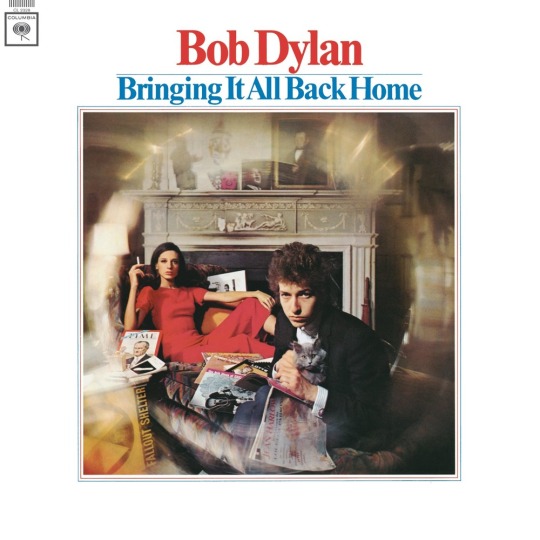
“Dr. Evil’s initial plans for world domination with Mr. Bigglesworth insisted of employing transgressive politics and a ‘”counter culture” among the youth, but it backfired when he realised it only ever made the world a better place, and went bald and fat from the realisation. The chick was his mastermind, but died from lung cancer, and Bigglesworth lost hair from passive smoking.“
Album 0050
Bob Dylan - Bringing It All Back Home (1965)
Genre: Contemporary folk, Folk-rock
Patrick: Score: 6.5
Nik: I always did think that the cry of ‘Judas’ at the Albert Hall concert a whole year later was way too late, and in some cases pointless. As much as it is attributed, this album is not the first time Dylan went electric(it’s his first fucking single in fact), but that’s besides the point. Dylan already published three electric albums and he proved, long ago, in this very album, that he just didn’t care about what chained responsibilities he’s supposed to have as a communal artist. The controversy should’ve died by that point. I’m surprised he didn’t just give a tired yawn as a response, but it wouldn’t make it for as a dramatic opener for Like a Rolling Stone. I wouldn’t be surprised if he saw that coming and wanted to maintain a clean image.
Dylan’s idea was simple and in retrospect generously thoughtful. Why should R&B and rock have all the fun? How much harm would a folk track endure from having a booty-shaking backbeat, and how much would it benefit? Turns out that the hunches were true: Having a folkie track does not give it an excuse to be unbearably boring. Still deeming that the departure would be too radical(plus the songs on this album do more than just flip the bird on Greenwich Village and his protester fans), he still divided the album’s sides into the electric A-side and the classically acoustic B-side, but as a sly ace up his sleeve he probably saved his heaviest songs for the B-side even if they were just acoustic. The entire album is jamming but it is not musically challenging, but uses its music to provide a jolly fuel for the really playful imagery that rests in the lyrics.
In some parts it’s The Beatles that tipped Dylan over the edge to try doing rock. Their fabled meeting in New York on August 1964 served as an important cultural exchange, after which Dylan became convinced that this was the decade when fresh young faces with honest hearts and sharp minds would change society forever, and he wanted to catch up to the trend of pop rock so he could become an even bigger voice. On the other end of the bargain, The Beatles(mostly George and John) realised writing deep and thought-provoking lyrics was awesome, AND they got free weed on the side. At any rate, Dylan gave them proper thanks by giving them a cameo in a lyric of Bob Dylan’s 115th Dream, directly referencing Beatlemania and the daily grind of being suffocated by fangirls.
Whatever happened to the 113 other dreams?
Since Freewheelin’ Bob Dylan and Bringing It All Back Home are two years apart, all I could conclude is that dreams and the subconscious became Dylan’s muse in those two years, when he had to, grudgingly, oblige in being a protester folkie for the proto-counterculture, but realising it’s not a good life, when he’s just slaving away, writing songs, doing only what they tell him while Peter, Paul and Mary get to take his songs and land a #1 hit with each of them, he’s had it. He’s going to be his own man, bring a novel amount of individualism and authorship in his records, and the only ones who would still follow him would be only those who are worthy.
Bringing It All Back Home, much like its predecessor Freewheelin’, is a milestone album in the sense that it feels like what we today think of an album: All originals, presented in a cohesive order with songs resonating with true, honest, and individual feeling at every step. But where Freehweelin’ was predictable, perhaps somewhat cheapened by its unassuming young boy image that is immensely relatable, singing about loves gained and lost and how he hates warfare and injustice(everyone can relate to that!), Bringing comes out not without a protagonist as much as a narrator of an avant-garde(well really, beatnik) play. The complexity of individual songs on Bringing It All Back varies, but not a single one of them falters in quality.
Subterranean Homesick Blues kicks things up with a speed and comedy of a Keystone Cops film, and Dylan lines rhymes upon rhymes upon rhymes barely anyone can catch up to, as if he’d lose track if he didn’t indulge in his Ginsberg-inspired stream of consciousness lyricism. Homesick Blues is a social picture, not so much a protester song that points the finger at a clear culprit, but documents the days of all sorts of urban people, the poets, the straight men, the drug-peddlers, the coppers, and the inevitable hypocrisies of each of them, each verse ending not in some profound piece of tackiness, but in causalities so common and comedic and yet, have a clear message that fit the bill so well. Homesick Blues might have been a song that Dylan’s purist fans would have appreciated had it not been electrified, but Dylan’s got other things up his sleeve anyway.
Dylan has songs that mercilessly attack the protesters he’s sided with, like Maggie’s Farm as a simple, extended allegory with painful goat-like moans that’s cleverly disguised as a simple song against general authority that is also a cry for help for Dylan and a personal begging to express himself as an artist(since the ideas in his head won’t give him peace), or Outlaw Blues, a mindblowingly heavy blues banger that’s about, you guessed it, Dylan being tired from being pestered by his fake fans from all sides and wanting to escape to Australian mountain ranges. To add salt to the wound, Bob Dylan’s 115th Dream begins with what’s almost an acoustic intro, before failing the take and bursting into laughter, and coming back stronger and tighter as a complete rock band telling a linear, cartoonish story without overarching morals but a one way ticket across the USA first-hand.
His love songs on Side A continue the simplistic tradition of Freewheelin’, but do not shame on talking about the darker sides of relationships. The ironically titled She Belongs to Me has Dylan resume his handsome and sweet mistletoe-holding chords from Don’t Think Twice, but talks about a possessive love and empowered women who have immeasurable strength, talent and determination no lover can cope with. Love Minus Zero/No Limit returns to classical gender roles, with surreal lyrics that never feel out of place(‘Statues made of match sticks‘ is pretty sick), but whereas the lady in the song is an admirable and unbiased free spirit, a true love come true, it is also a love so frail and so easy to fall pray to injuries, from either the world itself or the very sardonic lover she accompanied herself with.
Side B is the stuff of legends. While it is purely acoustic, it is rife with lyricism so challenging that not a lot of people would be sure what to piece out of them(though even that does not rise to the ankles of Highway 61 and Blonde on Blonde which we’ll talk about later). Mr. Tambourine Man, which people only know as as ‘that pot song The Byrds did’, gets its earnest treatment by its original writer. Tambourine Man is a simple song about dreaming and escapism, but also of the power of imagination, the beauty of sleep and music, that uses vivid imagery of waves and the sky to paint the physical feel of its mental imagery. It is really meant to be a soft and cuddly song, a lullaby, as much as hippies like to think the ‘magic swirling ship’ is a direct reference to LSD or what-have-you. If you really feel into the song, then even Dylan’s annoying, nasal repeat of the refrain will sound like a jolly and innocent phrase that sounds like a part of a sleeping incantation.
The following two songs are mammoths that far outweigh every other track on the album. Gates of Eden is a song that Dylan sings like a man possessed, imagery fueled by power of pure and unpalpable conviction. When Plato said artists in his perfect Republic were too dangerous because they fall under spell of inspiration, this is what he meant. In it Dylan puts scenes of social and moral decay seeking salvation or meaning, a place where they could call Eden, whereas the narrator reminds that the Eden they seek for is where they live in already, but they forfeit to act accordingly and as good people, the black bookend for each of the short stories being ‘And there are no _ inside the Gates of Eden‘ while Dylan gazes with silent fury and a thousand-yard stare capable of cutting through diamond.
Performing Gates of Eden must have sucked all the life and good will out of Dylan that it has become twilight, but he still has to perform all 7:32 minutes of It’s Alright Ma (I’m Only Bleeding), which I always think is one of the best, if not the outright best song Dylan has ever written. His opening guitar line rings without reverb, the choruses descend chromatically while Dylan speaks in a bleak, egoless monotone voice about everyone and everything in the world, like he’s become dead and a ghost and has nothing left adequate time to contemplate all of the world’s evils.
Darkness at the break of noon
Shadows even the silver spoon
The handmade blade, the child's balloon
Eclipses both the sun and moon
To understand you know too soon
There is no sense in trying
Everything you expected about this album has now become shrouded in twilight where everything is uncertain, nothing has gravity anymore, and you can’t tell where up and down is, what’s real and what’s not. Dylan sings in one of his most bitter and biting episodes, about the worth of engagement and fight, about sanctity and sacrilege, about repent and forgiveness, seemingly pointing the fingers at everyone, saying that none of them are right, and must rise above petty one-dimensional convictions to truly make a stand for the better. His imagery is one of the most gothic he’s ever put, talking about balloons eclipsing the sun, tacky figures of Jesus Christ that glow in the dark, the treacherous illusions and expectations of leaders, and the age old romanticised battle of the individual against society. Even Dylan himself is terrified of the thoughts he has, so much that he fears he’d be put to death at the end of the song if people could only see them.
The last song acts as an postlude after It’s Alright, Ma left everything to smoldering char, and despite how it also puts the listener in the perspective of a backlashed victim, whose young and naive outlook is challenged by the changing times, it is like the hope of the Pandora’s Box. Its message is one of heartwarming and resolute continuing, and is lyrically similar to Like a Rolling Stone, although while Rolling Stone celebrates escapade and the optimism of being free, Baby Blue does not mince words about how failure and a lack of secure things you had in life sucks, and deeply laments the personal losses of all kinds of people, no doubt many of them the victims of the ever-radical 50s and 60s.
Bringing It All Back Home is the boldest artistic statement ever made in rock music up to that point and I’m amazed Dylan managed to get away with it. This guy should have been taken away, with putting self-written beat poetry on the back cover to the loud politically charged lyricism on the record that’s spoken by a possessed madman... that doesn’t even know how to sing! People still expected a professional and polished singer in 1965 but Dylan don’t care and he just throws the notion out of the window. Bob Dylan was the man who made it possible to show the world once again where music really came from: The heart. Dylan would have died if he had not the final say in the imagery that pulsates with every fiber in his body, and those who thought he was an unintelligible eccentric, I will always feel endlessly sorry for, as they are missing a firework of honesty and creativity that rarely comes in a person’s lifetime.
And it’s all over now, baby blue...
Score: 10.0
AGGREGATE SCORE: 8.25
CHOICE CUTS:
Subterranean Homesick Blues
Mr. Tambourine Man
It’s Alright, Ma (I’m Only Bleeding)
#bob dylan#bringing it all back home#subterranean homesick blues#mr. tambourine man#it's alright ma (i'm only bleeding)#album review#1001 albums#patnik1001albums#folk#folk rock
1 note
·
View note
Photo
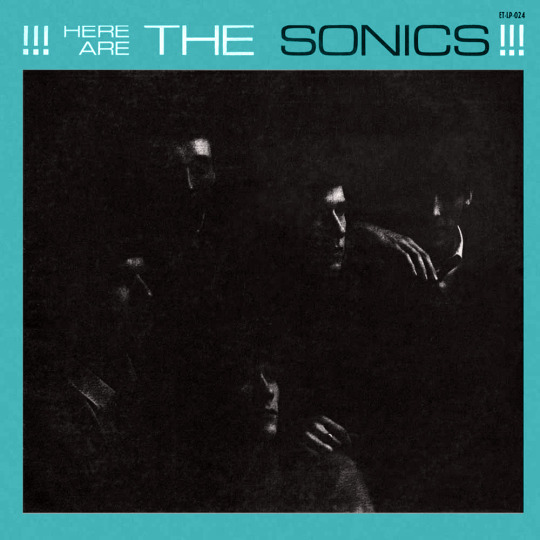
“A failed copying of the With the Beatles photoshooting session led to the development of the underexposed aesthetic and the necessity of the ISO option on digital cameras.“
Album 0049
The Sonics - Here Are The Sonics!!! (1965)
Genre: Garage rock, Proto-punk... Lo-fi indie?
Turns out that the last album we heard we got the wrong CD from our source, due to... reasons, so we beg you to discard it and forget it ever happened. This is an updated review meant to correct this mistake.
Patrick: At last, something to ease our pains. Fantastically lively and noisy as fuck rock.
Score: 8.5
Nik: Man, Louie Louie really did its trick. That song alone and the rise of the various British Invasion bands that proved you could make a career out of scratch with some good will gave birth to a plethora of aspiring groups in America on a shoestring budget, coining the garage rock trend, and proving you can still have 15 minutes of fame no matter how unremarkable or unpolished your group is. The Sonics seem to take the unpolished remark to the extreme, as all of the instrumentation on the record is recorded in extreme toaster quality. All the guitar lines and drum sets are lo-fi to the point of unrecognisability, and you’ll often be left wondering if the only saxophone they have actually sounds like a full brass band singing underwater in unison. When opening the album I legitemately thought if I hadn’t loaded Sister Ray on my music player by mistake.
The Sonics as a group are very competent and have a respectable songbook. Four tracks in here are originals out of total 12, the rest of which are 50s and early 60s rock and roll, R&B and soul songs interpreted in the jangly style of British Invasion groups. The Witch already tells the group is no laughing matter. It has an awkward, dissonant riff fueled by honking guitar with a backing organ, followed by a black, mortified guitar solo that had all its life sucked out of it. The Witch sounds like something that wouldn’t feel out of place in The Addams Family, and its cheesy black mood evokes the mood Black Sabbath would be known for on their own mammoth, gothic, titular track.
Psycho is another original and it sounds positively terrifying. It’s the one song I’d reckon where the already mysoginistic rockabilly lyrics about picking up birds really crosses the line into being scarilly deranged, as if the song was comically wanting to point that out. It has a groovy sax follow-up which is meant to give a bit of a soul feel to these rock songs, but with Gerry Roslie’s singing and screaming it just sounds so alarmingly concerning. Psycho does have this one hilarious moment near the ending where it awkwardly changes key at the end, meant to evoke uplifting sentiments after such a filthy and rowdy songs, and while it fails spectacularly, it is good to experiment in that way, which would echo production of psychedelic rock groups in later years.
The covers in here, unlike how I complain in other albums that they sound bland and unoriginal, in here are FANTASTIC. If you need any proof, just listen to their interpretation of Barrett Strong’s Money. Awesome surf-rock lead that transposes its lick to I-IV in a 12-bar fashion(which was a very wise decision concerning their lacking instrumentation and backing vocals), where the guitar also does a good part to fill the gaps the absence of backing vocals leave, giving a very characterised, punchy phrase after each of the verses, and a welcome edge to the track. Money is overall tight and keeps incredible momentum.
After Money we have Walkin’ the Do- ah, fuck no
They do a cover of The Contours’ Do You Love Me, and I can see why they picked that as one of the covers since the original is pretty intense, and The Sonics’ own version opens with a blitzkrieg of bashing percussion that almost sounds like beating up trashcans. They also manage to harmonise quite lovely, and it sounds so pretty in lo-fi for some reason. It’s a significant novelty.
Tracks like Dirty Robber and Have Love Will Travel have a very tacky mid-50s, American Graffiti sax solo to them, but on the latter track it attacks in such an unskillful tremolo barage of single notes it sounded as if it predicted Peter Brotzmann’s Machine Gun.
Here Are The Sonics is a fantastic and remarkably cohesive landmark of an album, that has sadly went by completely forgotten, and was anyway surpassed by the more daring and artistic ventures of The Velvet Underground, but The Sonics demonstrate a change was coming in the rock scene and a willingness to be uncompromisingly different in an era still chained by 12-bar structures and where groups with more spunk than talent were just awkwardly figuring out how to make a name for themselves, not for rock as a vapid, deity-worshipping stardom, but as an expression, and an idea that just had to be shared. It bears no significant weak points and in today’s context is a fascinating record worth of many jamming listens.
Score: 7.5
AGGREGATE SCORE: 8.0
CHOICE CUTS:
The Witch
Do You Love Me
Money
5 notes
·
View notes
Photo

The Sonics - Boom (1965)
Genres: Butt-rock, harsh noise, nightcore
Patrick: I have no idea what this bullshit drivel is. This is a total wreck from start to finish. I get it they were trying to be artsy and forward-thinking but all it amounts to is a load of self-indulging nonsense.
Score: 0.0
Nik: The Sonics were an influential garage rock band from America whose conception of hard rock was so pervasive in the underground it influenced the likes of Led Zeppelin, Nirvana and Nickelback, but were also noise pioneers that I think even Merzbow might have learned something of. I’m personally amazed music such as this existed in 1965, when experimental art rock on the level of The Velvet Underground was still far and away. The track Live and Learn for example shows fantastic and uplifting chord progressions and harmony, and a guitar solo that invented Metallica two decades before Metallica was a thing. Other cuts include the Dreams of an Absolution (Nightcore Remix) that daringly experiments with tempo and textures. I can’t imagine anyone from the sixties having the constitution to take in this track, as its high pitches and octave-breaking structures must have been too avant-garde for people to appreciate.
The absolute cutter must have been the 30-minute and the appropriately titled SANIC HEGEHOG EXTENDED 30 MINUTES OF GOING FAST, a harsh noise pioneer. I’m honestly shocked people don’t know about the Sonics more than they do, instead clinging to the belief that it was Metal Machine Music that invented harsh noise as listenable music. Unlike harsh noise that came after, SANIC HEGEHOG EXTENDED 30 MINUTES OF GOING FAST at least has face and a cohesive structure of verses and choruses, modulations underneath its harsh and pummeling exterior, and that says a lot about what people’s conception of music and its adoring qualities were of the time. This album is one for the ages.
Score: 10.0
AGGREGATE SCORE: 5.0
CHOICE CUTS:
SANIC HEGEHOG EXTENDED 30 MINUTES OF GOING FAST
Dreams of an Absolution (Nightcore Remix)
1 note
·
View note
Photo
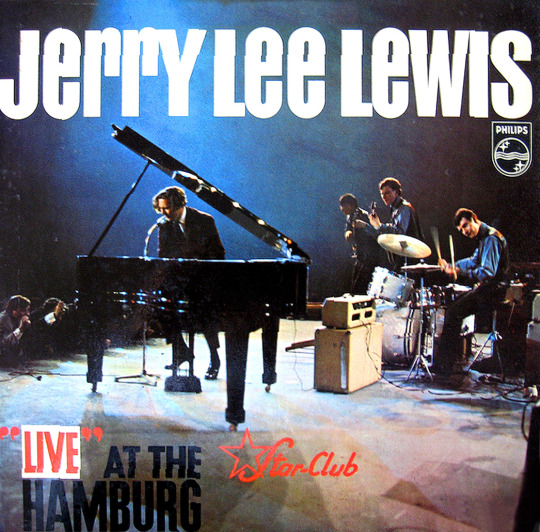
I apologise for the album cover, it looks like those VHS aesthetic gifs. Arguably the best thing to come out of it.
Album 0048
Jerry Lee Lewis - Live at the Star-Club, Hamburg (1964)
Genre: Rock & Roll
Patrick: This wasn’t at all that exciting as you promised. Apply yourself.
Score: 5.5
Nik: Another performance I thought would let me transfixed, but it has not. And this is Jerry Lewis we’re talking about.
The Star Club in Hamburg is a monolithic place that harbored many would-be wanderers and had them perform, including Ray Charles, Bo Diddley, Little Richard, notably The Beatles who had a baptism by fire while playing in Hamburg since 1960... and Jerry Lewis’ performance was one nearly by accident, but also a fresh take on a fresh audience after his popularity sank in the end of the 50s after to the Myra Brown scandal. His repertoire here features nothing but all-time R&B hits: Barrett Strong’s Money, Carl Perkins’ Matchbox, Ray Charles’ What’d I Say, Little Richard’s Long Tall Sally and Good Golly, Miss Molly, Elvis Presley’s Hound Dog, and yes, Jerry Lewis’ own Great Balls of Fire with Whole Lotta Shakin’ Goin' On.
Many journalists depict this concert as something legendary, describing it with such oft-seen remarks as the peak of rock and roll, the essence of rock and roll, and so on. It is true that Jerry Lewis gives a thumping performance that’s impossible to catch up with, no countdowns(listen to the crowd laugh on Great Balls of Fire as the Nashville Teens hurriedly pick up their instruments), no synchronised endings, piano keys pummeled, but it’s not like he wasn’t known for doing these things before(Why he hasn’t even set the piano on flame! The nerve!). The choice of tracks is certainly impressive and one that gets my appraisal, but if I’m watching covers I would, as I have said so many times before, much rather see an artist’s unique interpretation of it. In here no matter how energetic or hard-hitting the performances are, the songs just play as bad copies of the originals, and in my opinion lose the charm that those originals had. Who would want to listen to Barrett Strong’s Money or What’d I Say without the laidback groviness, the backing soul harmonies, instead being reinterpreted as just another rockabilly with piano? Jerry barely even sings, he is mostly just screaming, with no degree of finesse. For me this is something a record like this criminally lacks. A certain brand of uniqueness, otherwise this is just another Jerry Lewis album, a by-the-books cover job, that serves no purpose save that, perhaps, it is the only record with the clairvoyance to save Elvis and Little Richard tracks onto one LP for accessibility, but such a format in today’s times does not make sense, when you can hear the originals that are so much better and well-put together. Well at least I can’t complain about Great Balls of Fire not sounding good...
Some tracks like Matchbox certainly come as a cool exception, as on it for example comes this ferocious guitar with a sound unmatched by anything in 1964, save for The Kinks. On What’d I Say and Whole Lotta Shakin’ Goin’ On he comes up with these ad-libbed Isley Brother-isms as show stirrers, which certainly lead songs into unpredictable, but still charted territory.
I played this album loudly on headphones and yet still I almost fell asleep. This album would’ve been a mighty shocker maybe in say, 1958 or 9, but in 1964 ol’ Lewis was slowly about to get left behind. The British Invasion was already deeply challenging many people’s perception of rock as artistry, and the success of The Beatles and Bob Dylan already proved an incentive to invite people into independent songwriting.
As of this writing, Jerry Lee Lewis is still alive, and still kickin’. As is Chuck Berry. And Little Richard... Christ, that is certainly very commendable for all those people. They are straight examples of living fossils.
This has the proto-punk tag on RYM as one of the subgenres? What the fuck?
Score: 5.5
AGGREGATE SCORE: 5.5
CHOICE CUTS:
Great Balls of Fire
Matchbox
#jerry lee lewis#star club#live at the star-club#hamburg#rock and roll#rockabilly#great balls of fire#1001 albums#patnik1001albums
1 note
·
View note
Photo
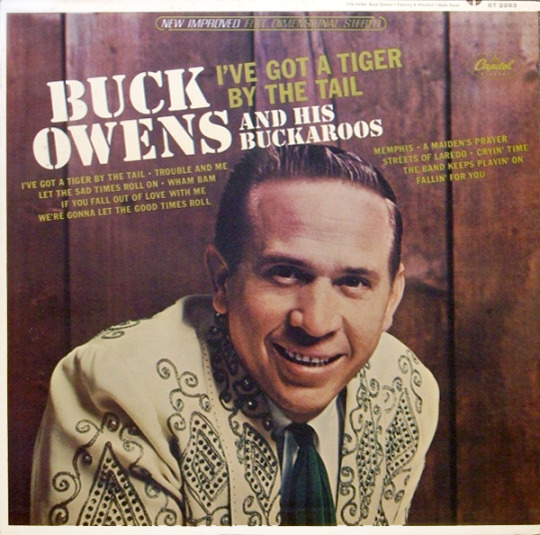
“I’ve kept this tiger inside my ass for two years back in the ‘Nam...“
Album 0047
Buck Owens and His Buckaroos - I’ve Got a Tiger by the Tail (1965)
Genre: Bakersfield Sound
Patrick: Score: 4.5
Nik: Welcome aboard, pardner! We got back to that ol’ rootin, tootin, country sound. Yeehaw!
Bakersfield is an interesting fusion of country with twangy slide guitar and rock and roll backbeat. Compared to the other country albums we’ve listened, Buck Owens at the very least offers a face-up environment of jovial moods, contrasted to the more conservative and tragic stories about cheating and death we’ve had in other country albums(Louvin Brothers and Johnny Cash already had their fill). This is at least the kind of country album you can put on and can’t help but smile at the honest cheesiness.
Buck’s vocal range is also deeply pleasant and harmonises so well, and the atmosphere overall is very loose and flowery, but the song structures themselves don’t have a lot to talk about(blues-sterile too, to boot), it’s ordinary chart-topping country as it is. Lyrical themes deal with love approached, gained, and lost, while others are decidedly humorous, like the proclamation in Wham Bam, where the protagonist politely refuses a woman’s hand, claiming that ‘the first thing is matrimony, next is alimony‘.
The famous Cryin’ Time is included in this album, and is probably the only reason this record made it into the book. It’s a wonderful showcase of the best things Buck is capable of and it’s a shame not all the other songs on here have such a magnificent and sentimental depiction of longing(just look at that stressed accent at ‘eyeeees’ at the end of the verse). The record ends with a pretty groovy, bass-heavy cover of Chuck Berry’s Memphis, Tennessee, but it may be more that song is such a personal favourite of mine.
Fine album worthy of its cuts, but while he’s got a tiger by the tail, nobody’s put a tiger in his tank :X
Score: 5.5
AGGREGATE SCORE: 5.0
CHOICE CUTS:
Cryin’ Time
Memphis (ignore the 1968 tag, this is well and through a 1965 recording)
#buck owens#cryin' time#i've got a tiger by the tail#country#rock#bakersfield sound#buckaroos#1001 albums#patnik1001albums
0 notes
Photo

“Tailing the Beatles every step of the way, now in full colour!”
Album 0046
The Rolling Stones - The Rolling Stones (1964)
Genre: British Rhythm & Blues
Patrick: Score: 5.0
Nik: I’ve always had a theory that The Beatles made great albums but shite singles while the Stones had great singles but shite albums(at least until Beggars Banquet). I can’t hold it against them, since The Beatles were largely responsible for shaping the album mentality we have today, while the first Stones record by comparison is only doing what lots and lots of disposable records of its time were doing. It’s a charmingly by-the-number blues covers record, odd choice for a debut of what today is a very raucious and iconic rock band, but back then you’d never expect such an artistic development from a bunch of scowling British mods with a loud sneer and a passion for Muddy Waters. The latter isn’t what they got famous for, though, as people were disinterested in second-hand blues mythos, and I suppose it is partly because of that that Jagger/Richards wanted to write their own songs.
This album has everything from Slim Harpo to Chuck Berry to Bo Diddley, fully immitating that dirty, lo-fi Chess Records sound but washed over with hormones of angry white men. I always found it interesting that the Stones’ idea of blues was always more confrontational than the laments and tragedies black artists would write. Stylistically there is nothing too much to say about these covers, they are perfect copies with a more crystal clear structure, only for Jagger’s vocals adding a new edge to the songs. Perhaps the song that benefits the most from it is Chuck Berry’s Carol, whose front-sighted monotony gives turns the song into a powerful driving force. Other covers include Willie Dixon’s I Just Want to Make Love to You(although the original had way more finese and the kind of groove that translated into Etta James’ rendition, which is awesome), and a at-one-moment-novel-and-the-other-annoying innuendo wagon of Walking the Dog.
Like, Christ, Jagger, we get it, you like walking the dog. What a filthy song.
The only original tracks on here are an inoffesnive 12-bar instrumental called Now I’ve Got a Witness, an oh-my-god-it-actually-sounds-like-the-rolling-stones blues track Little by Little (’co-written’ by Phil Spector but really all he did was shake the maracas), and the actually pretty good Tell Me, the only unashamed composition here that proudly carries the Jagger/Richards songwriting credit.
Tell Me is vastly different from the rest of the album because it poses itself as an acoustic soul ballad, no doubt taking lessons from The Beatles, but it also has a steady groove and nearly syncopated beat that sounds like something Sam Cooke or The Marvelettes would be happy to play. The chord progression is essentially Please Mr. Postman with the same layers of backing vocals, but isn’t afraid of adding expansion ideas of its own. Verse-bridge-chorus transitions have uniquely different dynamics that don’t awkwardly seague, and it has a very lovely guitar solo in the middle. Amazingly heavy bass, too.
Tell Me isn’t the perfect song, but it’s kind of thing that shows that just a little bit of originality really goes a long way, and is the only thing I managed to pick from this album that stood the test of time. Otherwise, this album is completely obsolete. With a decade where songwriting authenticity is slowly getting more and more appreciated and The Beatles already lead the game ahead, they have much to catch up to.
But don’t worry, Stones!
Score: YOU CAN MAKE IT.... IF YOU TRY/10
AGGREGATE SCORE: 5.0
CHOICE CUTS:
Tell Me (You’re Coming Back)
Carol
#the rolling stones#keith richards#mick jagger#brian jones#the beatles#british invasion#1001 albums#rhythm and blues#blues#patnik1001albums#debut
0 notes
Photo
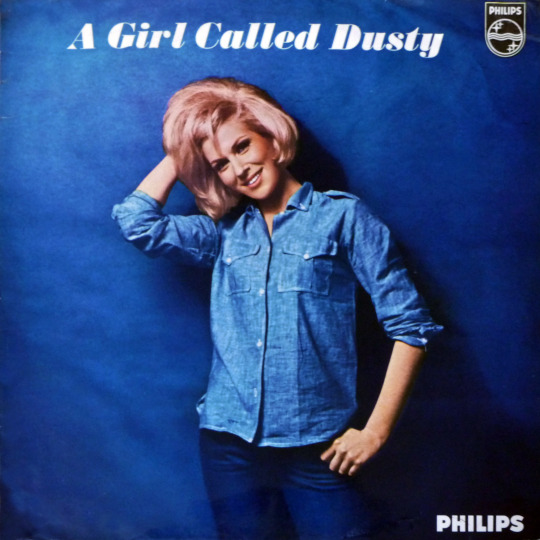
“University research confirms most hair bombing incidents from the 1960s onwards can be directly attributed to Dusty Springfield.”
Album 0045
Dusty Springfield - A Girl Called Dusty (1964)
Genre: Blue-Eyed Soul
Patrick: Score: 7.0
Nik: In the middle of all the British invasion business also comes Dusty Springfield, proving even further how strong the brill building and Motown game was in the UK after the prototype known as Helen Shapiro proved to be a success. Though she didn't take the DIY approach The Beatles had(who of course were also captivated learners of American soul), and only did covers, the choice of songs here is fantastic, all courtesy of American soul labels like Motown, Atlantic and Scepter, nicked from the likes of The Shirelles(the album opens with the chair flipping Mama Says), the Supremes, and including three(THREE!!!) delicious Bacharach/David tunes.
These are all competent covers and Dusty is charming and accomplished as a singer, they bring all the flair and spirit of the originals, to the point where all the arrangement and delivery styles are nearly identical copies... leaving so little window of opportunity for Dusty to take her own spin on these songs(outside of maybe Ray Charles’ Don’t You Know, which does the impressive achievement of being more unbuttoned and heated than the original, and this is Ray Charles we’re talking about). It’s as if they wanted to make a compilation LP of the best soul hits from America but couldn’t get the rights to it and instead commissioned Dusty to do covers of them because it’s cheaper. This paints an unintentional, but very unfortunate picture of white artists exploiting the image and success of black artists while bringing nothing new, something that’s been going since even in the early rock and roll era. When you compare Mama Says or the Supremes’ When the Lovelight Starts Shining Through His Eyes, in original and cover form, you’d be forgiven if you wouldn’t be able to tell the difference, or even the ethnicity of the singer in question. This makes this album difficult to review because essentially the only way I could would be if I talked about the original versions of these songs.
Composition-wise, the notable tracks on here are Mama Says, You Don’t Own Me, Colouring Book, and of course the three Burt Bacharach songs; Twenty-Four Hours from Tulsa, Anyone Who Had a Heart, and Wishin’ and Hopin’(first one by Gene Pitney, other two by Dionne Warwick). Obviously these tracks are as joyful as anything in the world, but today you’d be better off getting the tracks in their original form; more difficult in 60s England where records were much tougher to get by and you had to turn to Dusty for your annual soul fix. Good if you’re lazy, anyway.
Score: 6.0
AGGREGATE SCORE: 6.5
CHOICE CUTS:
Anyone Who Had a Heart
Don’t You Know
#dusty springfield#a girl called dusty#soul#blue-eyed soul#motown#atlantic#stax#brill building#burt bacharach
0 notes
Photo
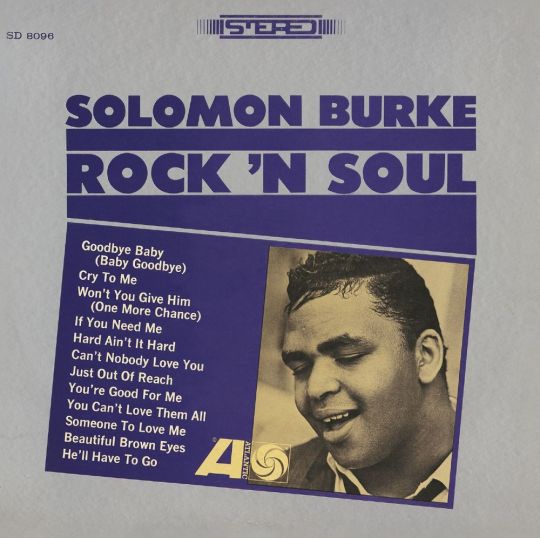
“Oh, it’s a Grammy.“
Album 0044
Solomon Burke - Rock ‘n’ Soul (1964)
Genre: Southern Soul, Rhythm and Blues
Patrick: Score: 5.0
Nik: This doesn’t work well. When you’re hopping on a trend and mesh genre influences for the sake of it instead of making honest songs, you’re not doing anything too memorable. The bunch of the songs on here came from the Billboard Top 100 and they’re competent enough covers with RnB backing band(rock guitars, brass sections, etc), but they are just not that memorable. Or aged well.
Solomon sadly just doesn’t have a good characteristic to himself. He can croon, he can shout and shimmy, but he’s just coming off as a cheaper and more rockist Sam Cooke instead. The funky, shuffly Cry to Me is the only track that really stands out to me in any way.
If Solomon Burke is capable of more than this then sure, I’d like to hear it, and I’d like to believe it’s the safe songlist choice on this album that makes this so uninteresting.
Score: 4.0
AGGREGATE SCORE: 4.5
CHOICE CUTS:
Goodbye Baby (Baby Goodbye)
Cry to Me
0 notes
Photo
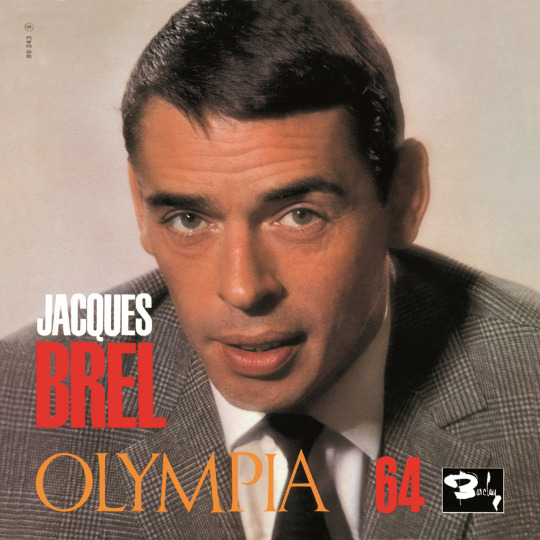
“Includes the hit single Amsterdam I Love You But You’re Bringing Me Down.“
Album 0043
Jacques Brel - Enregistrement Public à l'Olympia 1964 (1964)
Genre: Chanson
Patrick: Score: 7.0
Nik: Previously only having experience with Brel with his Ne me quitte pas single, this was a foray I really enjoyed, and the recording quality on the live concert is suitable enough to be considered equal with studio recordings. Naturally I had to look into (translated) lyrics as chanson is just lyrical by nature to get my full enjoyment.
Each of the chansons in this record is a picturesque look into places and kinds of people, such as the opener Amsterdam that paints a very decadent picture of its port district and their melancholy, seabound sailors. Contemporary pop of mainland Europe always loved painting romanticised and tragic pictures of various kinds of people(even of other nationalities, like in Les toros) in their songs, and this song is considered a classic in this tradition. A word must be said for the fantastic arangements Brel brought onto the stage, outside of the accordions, double bass, and piano, for example, the second track Les timides that brings in a neat triangle or bell for effect.
A big favourite of mine is Les jardins du casino(The Casino Garden), for its upbeat tone, consistent musical structure and satirical look into society, but also for Brel’s showmanship and ability to engage in all sorts of moods and tempo with his singing, that can at one moment burn with possessed, visceral passion and other moments sound so sparse and fragile. Les timides(Timid Ones) and Les vieux(The Old Ones) show a good example of the latter, especially since their lyrics talk about heart-breaking experiences from the angles of such people.
“The old people no longer move, their movements have too many wrinkles, their world is too little
From the bed to the window, then from the bed to the armchair and from the bed to the bed”
The album closes with a really impressive and sullen Le plat pays(The Flat Land), a true love song for the Netherlands, with some of Brel’s most intense imagery other than the raging volcanos and red and black skies from Ne me quitte pas. The vibe is set by Brel’s breathy vocals, a close and intimate classical piano backing and what I swear is a theremin, and it continues into Brel’s desolate peeks into the four corners of the world and where their rivers take them.
The bonus tracks on the reissues must not be ignored, they are as catchy and as lyrically beautiful as the rest of the songs on the first album pressing. A particular gem is the song Jef, which is envisioned as a pep-talk for a person so destroyed on all fronts by a woman he’s obsessed with.
Score: 7.5
AGGREGATE SCORE: 7.25
CHOICE CUTS:
Amsterdam
Les jardins du casino
Le plat pays
1 note
·
View note
Photo
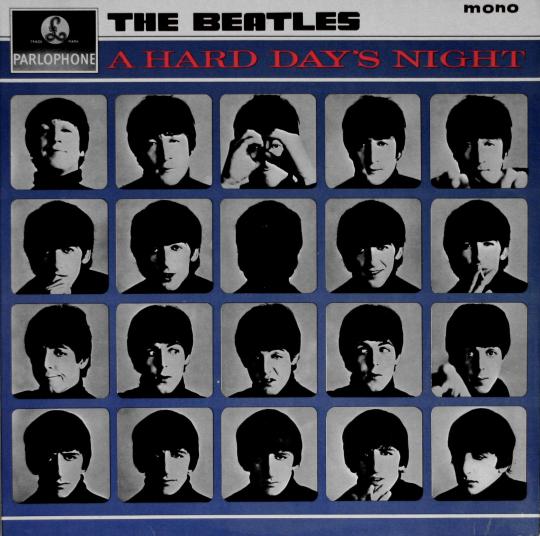
“In which The Beatles embrace their Andy Warhol aesthetic.”
Album 0042
The Beatles - A Hard Day’s Night (1964)
Genre: Merseybeat, Pop Rock
Patrick: Was pretty nice. Just think how this record got out the same year Getz/Gilberto did.
Score: 7.0
Nik: A Hard Day’s Night is the first Beatles release to contain solely original compositions until Rubber Soul. And a brunt of them had to be written by John Lennon, and having to write half an album’s worth to meet the deadline for the planned film of the same name, this record had to deal with a fair share of uninspired misses, as much as blissful standouts that outweigh them.
Though the songwriting in this album is not as consistent than in With the Beatles, and is stick to a more conventional form of pop and chord changes, The Beatles didn’t forfeit innovation completely: Any other way the opening title track might have been an obscure chapter in the Beatles popular culture, but it documents George’s penchant for his new 12-string Rickenbacker, which not only provided the puzzling, alient opening chord to the track, but also a mod-flavoured laser-precise guitar solo. The most exotic is the ending fadeout, that same guitar providing modulating arpeggios that seem to soar to the high heavens: A very unusual and strangely prophetic way to end a rock song, a sort of call to liberty and the entire counterculture of the 60s that would spawn it, unlike with a cymbal crash or a punch in E.
There’s something very special about the second track, I Should Have Known Better, with its use of harmonica less as a melodic instrument like in their previous songs, but a symbol for western freedom(even more memorable because of its use in film), and its insistance on streching singing notes without altering pitch, or its hypnotic repeatance of scat. Even Please Please Me knew better than that. Any other pop musician of the time would’ve considered this a horrible lack of talent, and The Beatles were certainly trained(if crudely) singers, but this approach fits. The message a lot of people got from this was that musical passion should come out as raw as possible, as when a silly love song like this from an untrained singer could be more emotionally compelling than all the vocal training and complexity of a blues diva across the other side of the Atlantic could be, I think it is a hint for the change of atitudes that’s to come to popular music. The rest of the song plays off like a ballad, with confident, packed 7th and minor chords at every step during the chorus.
The other tracks on Side A, all of which were written specifically for the movie, seem courteously formal, as if to take the most wide-appealing traits of With the Beatles and do everything in their power to appeal to skeptical seniors. The overly sleepy and surface-level prettyness of If I Fell in Love With You and McCartney’s And I Love Her work as if they were expansions of Till There Was You, and I’m Happy Just to Dance With You with Tell Me Why represent more jovial filler, in-step perhaps compared to its contemporaries but a sidetracking from the group’s previous efforts. Can’t Buy Me Love is still a beast of a single, and had an even better music video many claim to have been in MTV’s lineage.
Side B of the album in contrast sounds much more like With the Beatles. Any Time at All has nearly the same descending bassline to a counterpoint and earnest vocal like It Won’t Be Long, and Things We Said Today represents an interesting prospect of McCartney trying to copy Lennon’s flat, harmonic, and dramatic sensibilities, and its chorus, with a thumping bass and romantic tension so heavy it can part mountains ends up being the most menacing thing Lennon never wrote for a long time. The other three tracks on there are stylistic re-imaginings of I Wanna Be Your Man that work better than the fleetway tracks on Side A, if you can get pass the corny lines on When I Get Home.
I’ll Be Back, that is the true gem of the album. It really shouldn’t even be here, but it doesn’t have a place on any other Beatles album either. It’s full of bubbling tension and constant modulating between major and minor, and is more than an illustrious look inside Lennon’s lyrical psychology. This song does not have a chorus, instead having two unique bridges that bind the verses: It was clearly meant by Lennon that it should be lived like an experience, every subsequent bridge trying to jab your heart strings even more. When Lennon sings “Iiiii thought that you would realise...“ his set of lyrics strike rapidly and sharply, reciting prose instead of singing a song with heavy hint of accusation, that one we find in the next bridge to be a frail one anyway: Just listen to the way he says(doesn’t sing, SAYS) “I wanna go“ that stops abruptly and awkwardly in the place where the first bridge’s “I love you so-oh-ooooh“, would melisma its way to achieve length. I always considered this the emotional peak of the album, and the song’s lack of resolve or proper ending into uncharted territories, instead of being tragic closer, signify a splash into uncharted waters, with many new possibilities for both the musical maturity of The Beatles, and for popular music as a whole.
Score: 9.0
AGGREGATE SCORE: 8.0
CHOICE CUTS:
A Hard Day’s Night
I Should Have Known Better
I’ll Be Back
3 notes
·
View notes
Photo
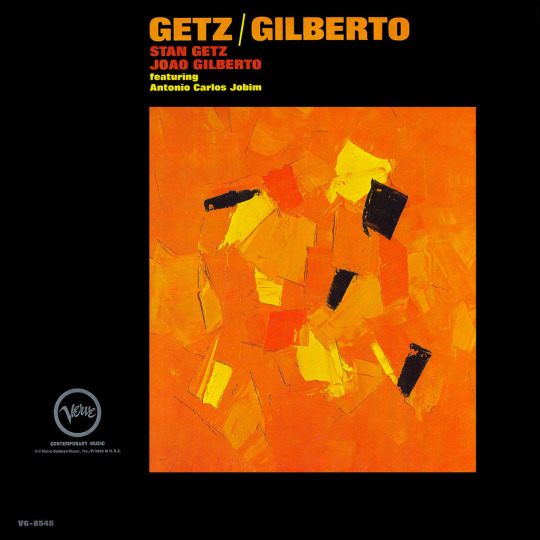
“Well I mean, it really says a lot when an album wins a Grammy Award in 1965.”
Album 0041
Stan Getz and João Gilberto - Getz/Gilberto (1964)
Genre: Bossa Nova, Samba-Jazz
Patrick: The Girl From Ipamena is sweet as everyone says it is, and I wish I could have gotten more of Astrud Gilberto’s singing in the album. Joao’s vocals seem so fake to me, ironically, with his soothing Spanish voice, and can barely see the rest of the album as more than kitsch. I wanted to turn this off by the 4th track.
Score: 4.5
Nik: This ain’t as bad as Jazz Samba, and for just The Girl From Ipamena alone, I can forgive this record everything. With its deceiving cadences The Girl From Ipamena is as soulful as the Mona Lisa and a forever essential marriage of jazz with pop song structure. It’s one for the ages, while the rest of the record puts a big effort on showing smooth soloing and a return to traditional-sounding cancion when, in fact, there is little need to. It’s a real shame, this album could sedate a horse if played at an improper time, the only variation being either the inclusion of a strumming classical guitar or saxophone as leading instruments. So Danco Samba, O Grande Amor, and Corcovado are the other interesting tracks, but you’re good with just The Girl From Ipamena.
Oh, and I haven’t read the lyrics. Forgive me for this, I am certain the lyrics are pretty.
Score: 5.5
AGGREGATE SCORE: 5.0
CHOICE CUTS:
The Girl From Ipamena
So Danco Samba
#stan getz#joao gilberto#astrud gilberto#the girl from ipamena#samba jazz#getz/gilberto#1001 albums#patnik1001albums
1 note
·
View note
Photo
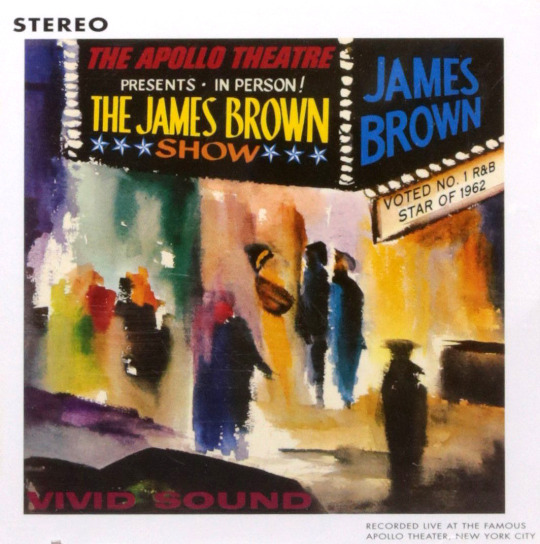
“When you pay your audience to listen to your shows is the truest hustling“
Album 0040
James Brown - Live at the Apollo (1963)
Genre: Funk, Soul
Patrick: Score: 6.5
Nik: In many ways this album is similar to Sam Cooke’s live record, but James Brown and Sam Cooke come from two fundamentally different musical backgrounds, James Brown fully embracing R&Bs spinoff into funk music, which he notably pioneered through the hits covered in the setlist of the titular Live at the Apollo. Brown’s antics are way crazier though and often you feel like half of the time you don’t even listen to the music, but just him baiting his audience and sharing engaging one-liners. The backing playing isn’t too much to brag about and the studio variations of Night Train and Try Me don’t falter in any way and might even feel better: This album is about Brown’s live presence, which truly shines in Think, the overly long jams of Lost Someone and the epic, romantic 6-minute long Please Please Please medley(I Love You Yes I Do sticks out as a particularly magic moment when the sound of the church organ overwhelms the stage as it transports the venue into another world). If it weren’t for those cuts(a good 19 minutes of the album, which is nearly two thirds of the record’s length), there’d be little point in publishing this live album, and even Brown’s own publisher refused to make a live album, which prompted James to fund this release from his own pocket. To no one’s surprise, it sold like hotcakes, and ensured Brown’s lasting musical growth and fame.
Score: 7.5
AGGREGATE SCORE: 7.0
CHOICE CUTS:
Think
Medley
1 note
·
View note
Photo

Wait. All this time I thought that was a trumpet but then I remembered Mingus doesn’t do trumpet and he was instead just smokin a pipe, wtf
Album 0039
Charles Mingus - The Black Saint and the Sinner Lady (1963)
Genre: Third Stream
Patrick: Although I still lament that we haven’t gotten a free jazz album yet, the brilliant Black Saint more than fills the spot till then.
Score: 9.0
Nik: God, how do I write this? I can’t do it justice...
Jazz evolution was a process that had to go through as many stages as human history. You had to have stages of classicism, renaissance, enlightenment, romanticism, and subsets of modernity. And though this time of jazz evolution to us seems like it merely sprung overnight, it is in truth a gerne of music that has existed for half a century, and had went through enough phases to have an entire generation grow up nurtured in its soundscape. So how convenient it was that the late 50s and 60s brought out the peak of expression and personal freedom of jazz musicians, who’ve taken upon themselves to put a seal to their black American herritage, and communicate this bonafide American art strictly on their own terms. All the livery stable blues, the Goodmans, the salt peanuts and the Kind of Blues, the feel like they’ve all been waiting to culminate into this point.
The Black Saint and the Sinner Lady is a jazz symphony split into movements with repeating themes and an uncompromising, very personal attitude and a magnificent portrait of a jaded and complicated psyche: It plays nothing but artfuly shattered fragments of Charles Mingus’ musical universe where Elington and Morton are god, angels play and dance to songs of ethnic Andalusia and Ethiopia, but indeed where a sense of aesthetic needs to be maintained: Even if by all practical definitions this album is largely unfocused and disonant, it strangely never feels out of harmony or forgetting its storyline.
Mingus’ king of the arsenal is the low-register brass instruments, intentionally meant to shock, arouse, incite, but most of all to make you shake from the force of power they hold of an angry and drunken man. Frequently people describe this album as being the best album to put on for heavy drinking. These groovy, hypnotic and mundane basses only made the high wind instruments that swim and fight out of the cesspit seem so much more like a fleshed out protagonist: Capable of every shade of emotion, its fears, desires, as well as a sense of action and resolve. Piano touches on act two paint a grotesque image and coupling the humble and ugly with the pretty and the object of yearning, only to break down in disappointment and melancholy, which brings back to anger and endlessly repeating cycles.
The famous Group Dancers theme played on flute backed by a descending bassline is the perfect leitmotif and a source of a shining light in our storyline, put head to toe to a Spanish guitar that brings fond memories of sun scorched deserts of Miles Davis’ Sketches of Spain, once again signaling the deadly spiral which Mingus’ emotional state tends to flow in, so much that it comes as a genuinely shocking moment when a lone alto sax loudly curses into the sky at the end, leaving a story cut halfway short with no resolution at Side A.
The only Side B track is a reimagining and reappropriation of the themes set in Side A, and this time it nearly breaks all convention of structure and fidelity, in a way that can be described as seemingly bipolar, manic, and violently struggling for a conclusion or a repose to that incessant turmoil that plagues the album, almsot begging to enter into free jazz territory. And then, somehow jumping back to the home of Solo Dancer’s basic Elington groove for a proper bookend, it’s like those scene in the movies where Mingus realises the answer he’s been looking for all this time has been in himself, and he sets out to do his usual riff like he always did, only with demonic ferosity that can almost destroy the world, as if to signal: I, Charles Mingus have been here and I leave my mark upon this soil, which he did in both the name of his soul, and his entire faustian jazz lineage that came before him.
And so I am forced to leave his praise and cry with my first ever 10.0. The world is permanently scarred, and jazz has attained its perfection and conclusion. Everyone can go home now.
Score: 10.0
AGGREGATE SCORE: 9.5
CHOICE CUTS:
Solo Dancer
Group Dancers
3 notes
·
View notes
